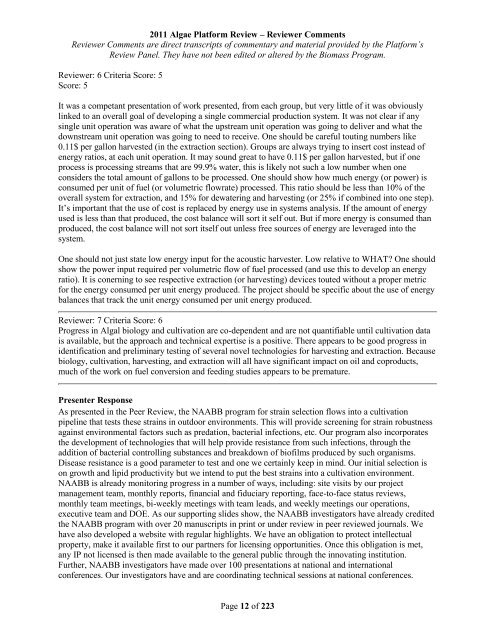Reviewer Comments - EERE
Reviewer Comments - EERE
Reviewer Comments - EERE
You also want an ePaper? Increase the reach of your titles
YUMPU automatically turns print PDFs into web optimized ePapers that Google loves.
2011 Algae Platform Review – <strong>Reviewer</strong> <strong>Comments</strong><br />
<strong>Reviewer</strong> <strong>Comments</strong> are direct transcripts of commentary and material provided by the Platform’s<br />
Review Panel. They have not been edited or altered by the Biomass Program.<br />
<strong>Reviewer</strong>: 6 Criteria Score: 5<br />
Score: 5<br />
It was a competant presentation of work presented, from each group, but very little of it was obviously<br />
linked to an overall goal of developing a single commercial production system. It was not clear if any<br />
single unit operation was aware of what the upstream unit operation was going to deliver and what the<br />
downstream unit operation was going to need to receive. One should be careful touting numbers like<br />
0.11$ per gallon harvested (in the extraction section). Groups are always trying to insert cost instead of<br />
energy ratios, at each unit operation. It may sound great to have 0.11$ per gallon harvested, but if one<br />
process is processing streams that are 99.9% water, this is likely not such a low number when one<br />
considers the total amount of gallons to be processed. One should show how much energy (or power) is<br />
consumed per unit of fuel (or volumetric flowrate) processed. This ratio should be less than 10% of the<br />
overall system for extraction, and 15% for dewatering and harvesting (or 25% if combined into one step).<br />
It’s important that the use of cost is replaced by energy use in systems analysis. If the amount of energy<br />
used is less than that produced, the cost balance will sort it self out. But if more energy is consumed than<br />
produced, the cost balance will not sort itself out unless free sources of energy are leveraged into the<br />
system.<br />
One should not just state low energy input for the acoustic harvester. Low relative to WHAT? One should<br />
show the power input required per volumetric flow of fuel processed (and use this to develop an energy<br />
ratio). It is conerning to see respective extraction (or harvesting) devices touted without a proper metric<br />
for the energy consumed per unit energy produced. The project should be specific about the use of energy<br />
balances that track the unit energy consumed per unit energy produced.<br />
<strong>Reviewer</strong>: 7 Criteria Score: 6<br />
Progress in Algal biology and cultivation are co-dependent and are not quantifiable until cultivation data<br />
is available, but the approach and technical expertise is a positive. There appears to be good progress in<br />
identification and preliminary testing of several novel technologies for harvesting and extraction. Because<br />
biology, cultivation, harvesting, and extraction will all have significant impact on oil and coproducts,<br />
much of the work on fuel conversion and feeding studies appears to be premature.<br />
Presenter Response<br />
As presented in the Peer Review, the NAABB program for strain selection flows into a cultivation<br />
pipeline that tests these strains in outdoor environments. This will provide screening for strain robustness<br />
against environmental factors such as predation, bacterial infections, etc. Our program also incorporates<br />
the development of technologies that will help provide resistance from such infections, through the<br />
addition of bacterial controlling substances and breakdown of biofilms produced by such organisms.<br />
Disease resistance is a good parameter to test and one we certainly keep in mind. Our initial selection is<br />
on growth and lipid productivity but we intend to put the best strains into a cultivation environment.<br />
NAABB is already monitoring progress in a number of ways, including: site visits by our project<br />
management team, monthly reports, financial and fiduciary reporting, face-to-face status reviews,<br />
monthly team meetings, bi-weekly meetings with team leads, and weekly meetings our operations,<br />
executive team and DOE. As our supporting slides show, the NAABB investigators have already credited<br />
the NAABB program with over 20 manuscripts in print or under review in peer reviewed journals. We<br />
have also developed a website with regular highlights. We have an obligation to protect intellectual<br />
property, make it available first to our partners for licensing opportunities. Once this obligation is met,<br />
any IP not licensed is then made available to the general public through the innovating institution.<br />
Further, NAABB investigators have made over 100 presentations at national and international<br />
conferences. Our investigators have and are coordinating technical sessions at national conferences.<br />
Page 12 of 223




